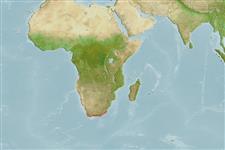Teleostei (teleosts) >
Gobiiformes (Gobies) >
Gobiidae (Gobies) > Gobiinae
Etymology: Caffrogobius: Arabic kafir = to be unbelieving; infidel, a word given by Arabs to all non moslems and also the region of Caffraria in South Africa (Ref. 45335).
More on author: Barnard.
Issue
Genus Eschmeyer, pers. comm.
Environment: milieu / climate zone / depth range / distribution range
Ecology
Marine; brackish; demersal; depth range 0 - 7 m (Ref. 5299). Subtropical
Southeast Atlantic: Namibia to East London, South Africa.
Size / Weight / Age
Maturity: Lm ? range ? - ? cm
Max length : 12.5 cm TL male/unsexed; (Ref. 11344)
Dorsal spines (total): 7; Dorsal soft rays (total): 9 - 11; Anal spines: 1; Anal soft rays: 9 - 10. Body with spots forming irregular longitudinal rows; black spot on posterior end of spinous dorsal; large males with faint vertical bands anteriorly; all fins (except caudal fin) dusky (Ref. 2798).
Occurs in estuarine, intertidal and inshore waters; usually on mud (Ref. 5299).
Life cycle and mating behavior
Maturities | Reproduction | Spawnings | Egg(s) | Fecundities | Larvae
Goren, M., 1996. A review of the southern African gobiid fish genus Caffrogobius Smitt, 1900. Spec. Publ. Smith Inst. Ichthyol. (57):1-28. (Ref. 12725)
IUCN Red List Status (Ref. 130435)
Threat to humans
Harmless
Human uses
Fisheries: of no interest
Tools
Special reports
Download XML
Internet sources
Estimates based on models
Preferred temperature (Ref.
123201): 14.5 - 25.2, mean 19.4 °C (based on 94 cells).
Phylogenetic diversity index (Ref.
82804): PD
50 = 0.5078 [Uniqueness, from 0.5 = low to 2.0 = high].
Bayesian length-weight: a=0.00708 (0.00333 - 0.01504), b=3.09 (2.92 - 3.26), in cm total length, based on LWR estimates for this (Sub)family-body shape (Ref.
93245).
Trophic level (Ref.
69278): 3.3 ±0.55 se; based on food items.
Resilience (Ref.
120179): High, minimum population doubling time less than 15 months (Preliminary K or Fecundity.).
Fishing Vulnerability (Ref.
59153): Low vulnerability (10 of 100).
